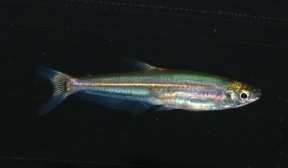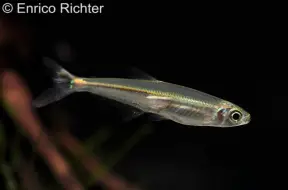Iguanodectes spilurus
Green Line Lizard Tetra
SynonymsTop ↑
Piabuca spilurus Günther, 1864; Iguanodectes tenuis Cope, 1872
Etymology
Iguanodectes: from the Taino iwana, meaning ‘lizard’, and Ancient Greek déktés, meaning ‘biter’.
spilurus: from the Ancient Greek σπῖλος (spilos), meaning ‘spot’, and οὐρά (oura), meaning ‘tail’, in reference to the dark marking on the caudal-fin.
Classification
Order: Characiformes Family: Iguanodectidae
Distribution
Widely-distributed throughout the Amazon, Orinoco, Essequibo, and Tocantins river systems in Brazil, Peru, Bolivia, Ecuador, Colombia, Venezuela, and Guyana.
Type locality is ‘Rio Cupai [= Rio Cupari], Rio Tapajós basin, Amazon River drainage, Pará State, Brazil’.
Habitat
Little information is available but presumably favours minor tributaries, smaller rivers, oxbows, and flooded forests rather than main river channels.
In the Orinoco system it is often associated with habitats known as morichals which tend to contain transparent, clear water and sandy substrates, often with dense growth of aquatic plants or riparian vegetation among which the fish take shelter.
In other parts of its range it has been collected from both flowing blackwater habitats and still floodplain lakes.
In the rio Manuripi, Bolivia, I. spilurus has been recorded to coexist with numerous other species including Carnegiella myersi, C. strigata, Hemigrammus unilineatus, H. lunatus, H. neptunus, Hyphessobrycon pando, Moenkhausia sanctaefilominae, M. coletti, M. oligolepis, M. dichroura, Gymnocorymbus thayeri, Nannostomus trifasciatus, Iguanodectes spilurus, Paragoniates alburnus, Prionobrama filigera, and Pyrrhulina vittata.
Maximum Standard Length
The largest specimen known to date measured 101.5 mm.
Aquarium SizeTop ↑
An aquarium with surface dimensions of 120 ∗ 45 cm or similar should be the smallest considered.
Maintenance
Probably most-suited to an arrangement comprising a sandy substrate plus some driftwood roots and branches, although it should also thrive in a planted set-up.
It goes without saying that this species is sensitive to poor water conditions and should never be introduced to biologically-immature aquaria.
Water Conditions
Temperature: 20 – 28 °C
pH: 5.0 – 7.5
Hardness: 18 – 215 ppm
Diet
Likely to be omnivorous feeding on small invertebrates, crustacea, filamentous algae, fallen fruit and suchlike in nature.
In aquaria it may survive on a diet of dried foods but like most fishes does best when offered a varied menu which in this case should also contain live and frozen chironomid larvae (bloodworm), mosquito larvae, Daphnia, Moina, etc.
Behaviour and CompatibilityTop ↑
Generally peaceful making it an ideal resident of the well-researched community aquarium.
It’s perhaps best-maintained alongside similarly-sized characids, gasteropelecids, lebiasinids, callichthyid or loricariid catfishes, and non-predatory cichlids.
Try to buy a mixed-sex group of at least 8-10 specimens, include other schooling fishes to provide security, and you’ll be rewarded with a more natural-looking spectacle.
The interaction between rival males is also interesting to watch and they will display their best colours when competing for female attention or hierarchical position within the group.
Buy more females than males if possible to avoid individuals being harassed excessively.
Sexual Dimorphism
Nuptial males develop hooks and lappets on the anterior anal-fin rays.
NotesTop ↑
This species has also been referred to as ‘slender’, ‘spindle’, or ‘iguana’ tetra, and it is the most widespread Iguanodectes species.
It can be told apart from other members of the genus by its translucent dorsal and anal fins, lack of red lateral stripe on the body and prominent dark caudal-fin marking.
Iguanodectes is a relatively small genus with less than ten member species and no additions since the early 1990s.
It is included in the family Iguanodectidae alongside the related genus Piabucus which is separated from Iguanodectes by possession of enlarged pectoral fins and a prominent pectoral keel.
This grouping was considered to represent a subfamily, Iguanodectinae, prior to phylogenetic analyses (Moreira, 2002; Mirande, 2010) although its monophyly was evidenced much earlier (Vari, 1977).
All iguanodectids possess the following characters: body elongate; teeth basally-contracted and multicuspid; gill membranes united and free from the isthmus; posterior end of maxilla not extending to eye; dorsal-fin origin normally positioned posterior to midbody (except in Iguanodectes geisleri in which it is at midbody); anal-fin long (except in I. geisleri).
In addition there is a process on the internal face of the dentary, the first proximal anal-fin pterygiophore is expanded and recurved posteriorly (except in I. geisleri), and the anterior portion of the posterior swimbladder chamber is thinner than the posterior portion (Moreira in Reis et al., 2003).
References
- Günther, A., 1864 - Catalogue of the fishes in the British Museum v. 5: i-xxii + 1-455
Catalogue of the Physostomi, containing the families Siluridae, Characinidae, Haplochitonidae, Sternoptychidae, Scopelidae, Stomiatidae in the collection of the British Museum. - Cope, E. D., 1872 - Proceedings of the Academy of Natural Sciences of Philadelphia v. 23: 250-294, Pls. 3-16
On the fishes of the Ambyiacu River. - Géry, J., 1977 - T. F. H. Publications, Neptune City, New Jersey: 1-672
Characoids of the World. - Hein, G., 2009 - Bulletin of Fish Biology 10(1/2): 1-10
Hyphessobrycon pando sp. n., a new rosy tetra from northern Bolivia (Teleostei, Characiformes, Characidae). - Mirande, J. M., 2010 - Neotropical Ichthyology 9(1): 385-568
Phylogeny of the family Characidae (Teleostei: Characiformes) from characters to taxonomy. - Moreira, C. R., 2002 - Unpublished Master Dissertation, Universidade de São Paulo, São Paulo: 276 p.
Relações Filogenéticas em Iguanodectinae (Teleostei; Characiformes; Characidae). - Ortega, H. and R. P. Vari, 1986 - Smithsonian Contributions to Zoology No. 437: iii + 25 p.
Annotated checklist of the freshwater fishes of Peru. - Reis, R. E., S. O. Kullander and C. J. Ferraris, Jr. (eds), 2003 - EDIPUCRS, Porto Alegre: i-xi + 1-729
Check list of the freshwater fishes of South and Central America. CLOFFSCA. - Taphorn, D. C., 1992 - Biollania Edición Especial - No. 4. Monografias Cientificas del Museo de Ciencias Naturales, UNELLEZ - Guanara, estado Portuguesa, Venezuela: 1-537
The characiform fishes of the Apure River drainage, Venezuela.




